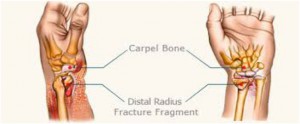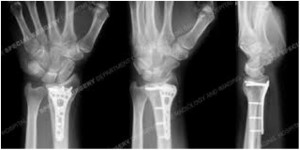Distal Radius Fracture Repair
The radius is the larger of the two bones of the forearm. The end toward the wrist is called the distal end. A fracture of the distal radius occurs when the area of the radius near the wrist breaks. Distal Radius Fractures are very common. In fact, the radius is the most commonly broken bone in the arm. A distal radius fracture almost always occurs about 1 inch from the end of the bone. The break can occur in many different ways, however. One of the most common distal radius fractures is a Colles fracture, in which the broken fragment of the radius tilts upward.
 Preparation for Distal Radius Fracture Repair
Preparation for Distal Radius Fracture Repair
Tell your health care provider what medicines you are taking. This includes medicines, supplements, or herbs you bought without a prescription.
- You may be asked to stop taking drugs that affect your blood’s ability to clot. These include aspirin, ibuprofen (Advil, Motrin), naproxen (Naprosyn, Aleve), and other drugs.
- Ask your health care provider which medicines you should still take on the day of your surgery.
- If you smoke, try to stop. Ask your health care provider for help. Smoking can slow healing.
- Let your health care provider know about any cold, flu, fever, herpes breakout, or other illness you may have before your surgery.
- You will usually be asked not to drink or eat anything for 6 – 12 hours before the procedure.
- Your health care provider will tell you when to arrive at the office. Arrive on time.
Distal Radius Fracture Repair Surgery
The patient is positioned so that the surgeon has access to the palm side of the forearm. The area is cleaned and sterilized, and anesthetic is administered. The surgery is performed on an outpatient basis in the operating room. Either regional anesthesia or general anesthesia is used to prevent pain during the operation. During the surgery, the alignment of the fracture, and use an implant to stabilize the pieces. In most cases, I use a low-profile plate and screws to fix the bones internally. This is called “open reduction and internal fixation” and requires an incision at the wrist. The orthopaedic hardware is covered by the skin and soft tissues of the wrist and rests against the surface of the bone. Rarely, an external frame and/or pins are used to keep the bones aligned, depending on the fracture type. The external frame and pins are temporary, and are removed after a few weeks once the bones have healed. This is called “external fixation” and “percutaneous pinning.”
Surgery does not really “heal” the fracture; it simply allows the bones to be held in good alignment while the body bridges the fracture site with new bone. This healing process takes a few weeks.
X-rays below demonstrate the surgical hardware commonly used (volar plate) with improved alignment of the distal radius fracture. In most cases, the ulnar styloid fracture does not require hardware fixation.
Distal Radius Fracture Repair Recovery
 Casting
Casting
The rule for bone healing in general is to expect a six-week period to ensure proper bone strength. One-two additional weeks of support in a removal plastic splint is generally advised. A stable fracture may be treated with a combination of casting and splinting throughout this healing period.
Internal Fixation
In most cases, a patient who has undergone internal fixation surgery for a distal radius fracture may begin gentle wrist range of motion within 1-2 weeks of surgery, after which time a removable splint is used to support the hand.
The plate that was surgically placed inside the arm/wrist at the time of surgery may be left in place or removed at a later date.
External Fixation
The external frame and pins are usually removed sequentially, beginning 3-6 weeks after surgery, followed by a few additional weeks of removable splint wear.
Risks of the Procedure
No surgery is risk-free. However, the risk of major complications from distal radius fixation is low. Possible complications include pain, bleeding, infection, swelling, stiffness, nonunion, malunion, implant-related tendon irritation, hardware failure, and damage to the surrounding nerves and blood vessels. A fracture which fails to unite is known as a nonunion. A fracture which heals with deformity is known as a malunion. Other complications are also possible but are uncommon.
